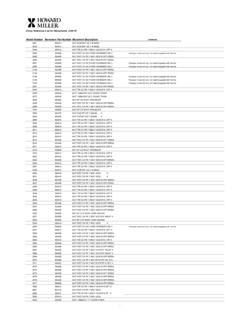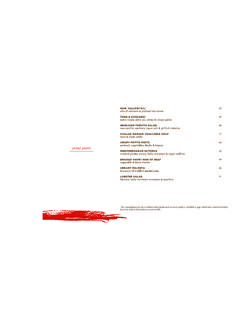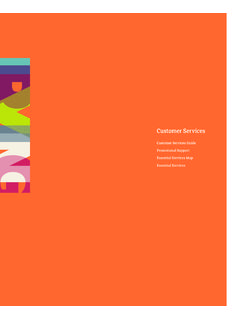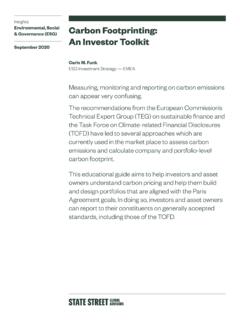Transcription of WHITE PAPER PAS 2060 FINAL - Cloudinary
1 WHITE PAPER . pas 2060 . THE FIRST STANDARD FOR carbon NEUTRALITY. January 2011. INTRODUCTION. Since the beginning of the last decade, companies looking for a robust response to climate change have often embraced carbon neutrality because of the simplicity of the concept. carbon neutral means just that: no net carbon impact. It's an approach that consumers can understand, and is a useful way for companies to differentiate themselves and prove their long-standing environmental commitment. After a number of high profile green wash cases in 2008, the concept began to suffer a crisis of confidence. Companies looking to approach carbon neutrality had no standard to follow that would ensure that their endeavours were robust against criticism, and consumers were unsure which carbon neutral claims they could trust.
2 pas 2060 was the response to this, developed by the British Standard Institution (BSi) to provide best-practice guidelines on how to achieve carbon neutrality in a way that is transparent and effective. We hope this WHITE PAPER will be useful for organisations considering carbon neutrality as a corporate response to climate change. THE CONCEPT OF carbon NEUTRALITY. carbon offsetting provides a mechanism where greenhouse emissions produced in one place are offset by emission reductions in another. These emission reductions are achieved by preventing emissions that would otherwise have been released in a business as usual' scenario, for example through the implementation of energy efficient technology, or where emissions are removed from the atmosphere through the plantation of new forests.
3 +The term carbon neutrality in its proper use indicates that the organisation or product to which it is referring to has contributed no net green house emissions to the atmosphere, its impact on climate change is zero. This is achieved by offsetting the emissions that cannot be reduced, as illustrated below: 2011 carbon CLEAR THE JOURNEY TO STANDARD. Since the term carbon neutrality has been in use, organisations have employed a range of methodologies to claim it. For example, some have measured a wide range of emissions including those from their supply chain (scope 3), while others have chosen a narrower focus.
4 There is also the distinction between those organisations that work to reduce their emissions and offset the net amount, and those that choose 100%. offsetting with no internal reductions. Prior to pas 2060 , the absence of regulation or a common standard outlining organisational boundaries, methodology, internal reduction requirements and type of offsets made it difficult for consumers to judge the credibility of carbon neutrality claims. This threatened to devalue the concept and in turn reduce incentives to organisations wishing to develop a carbon neutral approach. Organisations were also finding the question how best can I become carbon neutral?
5 Difficult to answer. Clearly the concept of carbon neutrality had reached maturity and an independent standard was needed to provide this guidance, increase consumer confidence and lend support to carbon neutral endeavours. Responding to this need, the BSi started the development of a Publicly Available Specification for the demonstration of carbon neutrality in 2009. It was introduced in April 2010 as pas 2060 after a series of consultations with the private, public and third sectors. 2011 carbon CLEAR The perils of green wash'. In the past many companies have learnt the hard way that green marketing is only effective if you have robust data to back your claims up.
6 Easy Jet told their customers that it was greener to fly with them than travel in a Toyota Prius and were subsequently ridiculed in the mainstream media. They calculated using atypical assumptions that the Prius would have just one passenger and that the flight was full. Following the criticism they removed the claim from their website. Ryman's carbon neutral claim also suffered public scrutiny and outrage from environmental groups as a result of an incomplete scope for measuring the product footprint (only production and transportation were included), and the fact that uncertified carbon offset credits were being used to support carbon neutrality.
7 Fiji Water marketed their bottled water on the basis that it was carbon negative, claiming more carbon was sequestered than emitted during production and consumption. As a result of using non-best practice forward' offsetting (where offset credits are used that have not yet been produced and certified) the company has been taken to court in California by claimants seeking restitution for the false claims from which [Fiji Water Company has] richly profited . The case will be heard in 2011. Eurostar and BSkyB were both reported to the Advertising Standards Authority in 2008. over their TV and newspaper ads claiming carbon neutral status.
8 Because they could show that they had measured and reduced their impact and offset with verifiable schemes, the ASA concluded that their ads were not misleading and that companies had substantiated their claims about carbon neutrality. The benefit of using pas 2060 is that it combines internationally recognised methodology with transparent reporting, protecting the organisation from unfair criticism. 2011 carbon CLEAR BENEFITS OF carbon NEUTRALITY. The benefits of carbon neutrality are both commercial and reputational. Being carbon neutral demonstrates environmental integrity, reduces risk, creates competitive advantage and, through emissions reductions, can help organisations to cut costs.
9 The fact that the specification was developed following recommendations from a wide range of industry and public sector players helps ensure that it is both robust and relevant. The focus is on both reductions and offsets, refuting criticism that offsetting alone is an insufficient corporate response to the threat of climate change. 2011 carbon CLEAR pas 2060 BASIC PRINCIPLES. The specification defines a consistent set of measures and requirements for entities ( organisations, governments, communities, families, individuals) to demonstrate carbon neutrality for a product, service, organisation, community, event or building.
10 The standard requires the following four stages: Measurement Reduction Document Offsetting and Validate Measurement The first step of the process is to undertake a carbon footprint of the product or organisation, using one of the allowed methodologies. For organisations the footprint standard should be either ISO14064-1 or GHG. Corporate Protocol, and for products and services it should be a PAS 2050 life-cycle assessment. The footprint measurements should include 100% of Scope 1 and Scope 2 emissions plus all Scope 3. emissions that contribute more than 1% of the total footprint . The Scopes can be defined as follows: Scope 1 - Direct Emissions; emissions from greenhouse gas sources owned or controlled by the organisation Scope 2 - Energy Indirect Emissions; emissions from the generation of imported electricity, heat or steam consumed by the organisation Scope 3 - Other Indirect Emissions; emissions which are consequences of an organisation's activities but arise from sources that are owned or controlled by other organisations.












